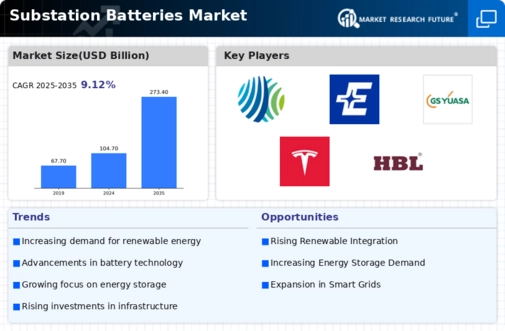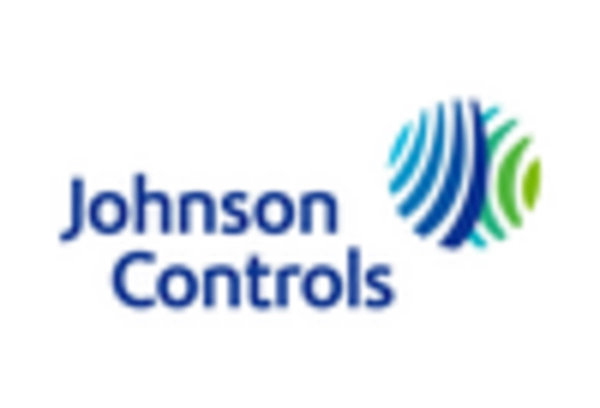-
Executive Summary
-
Market Introduction
-
Market Definition
-
Scope of the Study
-
Market Structure
-
Research Methodology
-
Primary Research
-
Secondary Research
-
Market size Estimation
-
Forecast Model
-
List of Assumptions
-
Market Landscape
-
Market Dynamics
-
Introduction
-
Market Drivers
-
Market Restraints
-
Market Opportunities
-
Porter’s Five Forces Analysis
- Threat of New Entrants
- Bargaining Power of Buyers
- Bargaining Power of Suppliers
- Threat of Substitutes
- Intensity of Rivalry
-
Value Chain/Supply Chain Analysis
-
Global Substation Batteries Market, By Type
-
Introduction
-
Lead Acid Batteries
- Market Estimates & Forecast, 2023-2032
- Market Estimates & Forecast, By Region, 2023-2032
- Sealed Batteries
- Vented Batteries
-
Nickel Cadmium Batteries
- Market Estimates & Forecast, By Region, 2023-2032
- Market Estimates & Forecast, By Region, 2023-2032
-
Global Substation Batteries Market, By Region
-
Introduction
-
North America
- Market Estimates & Forecast, By Type, 2023-2032
- Market Estimates & Forecast, By Country, 2023-2032
- US
- Canada
- Mexico
-
Europe
- Market Estimates & Forecast, By Type, 2023-2032
- Market Estimates & Forecast, By Country, 2023-2032
- Germany
- France
- UK
- Italy
- Rest of Europe
-
Asia-Pacific
- Market Estimates & Forecast, By Type, 2023-2032
- Market Estimates & Forecast, By Country, 2023-2032
- China
- India
- Japan
- Australia
- Malaysia
- Rest of Asia-Pacific
-
The Middle East
- Market Estimates & Forecast, By Type, 2023-2032
- Market Estimates & Forecast, By Country, 2023-2032
- Middle East
- Africa
-
South America
- Market Estimates & Forecast, By Type, 2023-2032
- Market Estimates & Forecast, By Country, 2023-2032
- Brazil
- Argentina
- Rest of South America
-
Competitive Landscape
-
Competitive Benchmarking of the Global Substation Batteries Market
-
Market Share Analysis: Global Substation Batteries Market
-
New Product Development in Substation Batteries Market
-
Mergers & Acquisitions in Substation Batteries Market
-
Partnership/Collaboration/Joint Ventures in Substation Batteries Market
-
Contracts & Agreements in Substation Batteries Market
-
Expansions & Investments in Substation Batteries Market
-
Company Profile
-
Johnson Controls Inc.
- Company Overview
- Product/Services Offering
- Financial Overview
- Key Developments
- Strategy
- SWOT Analysis
-
Exide Technologies
- Company Overview
- Product /Services Offering
- Financial Overview
- Key Developments
- Strategy
- SWOT Analysis
-
GS Yuasa
- Company Overview
- Product /Services Offering
- Financial Overview
- Key Developments
- Strategy
- SWOT Analysis
-
Robert Bosch GmbH
- Company Overview
- Product /Services Offering
- Financial Overview
- Key Developments
- Strategy
- SWOT Analysis
-
Saft Groupe S.A.
- Company Overview
- Product /Services Offering
- Financial Overview
- Key Developments
- Strategy
- SWOT Analysis
-
Storage Battery Systems, LLC
- Company Overview
- Product /Services Offering
- Financial Overview
- Key Developments
- Strategy
- SWOT Analysis
-
Tesla
- Company Overview
- Product /Services Offering
- Financial Overview
- Key Developments
- Strategy
- SWOT Analysis
-
HBL Power Systems Ltd.
- Company Overview
- Product /Services Offering
- Financial Overview
- Key Developments
- Strategy
- SWOT Analysis
-
-
List of Tables
-
Global Substation Batteries Market, By Region, 2023-2032 (USD Million)
-
North America Substation Batteries Market, By Country, 2023-2032 (USD Million)
-
Europe Substation Batteries Market, By Country, 2023-2032 (USD Million)
-
Asia-Pacific Substation Batteries Market, By Country, 2023-2032 (USD Million)
-
The Middle East & Africa Substation Batteries Market, By Country, 2023-2032 (USD Million)
-
South America Substation Batteries Market, By Country, 2023-2032 (USD Million)
-
Global Substation Batteries Market, By Type, 2023-2032 (USD Million)
-
North America Substation Batteries Market, By Type, 2023-2032 (USD Million)
-
Europe Substation Batteries Market, By Type, 2023-2032 (USD Million)
-
Asia-Pacific Substation Batteries Market, By Type, 2023-2032 (USD Million)
-
The Middle East & Africa Substation Batteries Market, By Type, 2023-2032 (USD Million)
-
South America Substation Batteries Market, By Type, 2023-2032 (USD Million)
-
Global Substation Batteries Market: By Region, 2023-2032 (USD Million)
-
North America Substation Batteries Market, By Country, 2023-2032 (USD Million)
-
North America Substation Batteries Market, By Type, 2023-2032 (USD Million)
-
US Substation Batteries Market, By Type, 2023-2032 (USD Million)
-
Canada Substation Batteries Market, By Type, 2023-2032 (USD Million)
-
Mexico Substation Batteries Market, By Type, 2023-2032 (USD Million)
-
Europe Substation Batteries Market, By Country, 2023-2032 (USD Million)
-
Europe Substation Batteries Market, By Type, 2023-2032 (USD Million)
-
UK Substation Batteries Market, By Type, 2023-2032 (USD Million)
-
France Substation Batteries Market, By Type, 2023-2032 (USD Million)
-
Italy Substation Batteries Market, By Type, 2023-2032 (USD Million)
-
Rest of Europe Substation Batteries Market, By Type, 2023-2032 (USD Million)
-
Asia-Pacific Substation Batteries Market, By Country, 2023-2032 (USD Million)
-
Asia-Pacific Substation Batteries Market, By Type, 2023-2032 (USD Million)
-
China Substation Batteries Market, By Type, 2023-2032 (USD Million)
-
India Substation Batteries Market, By Type, 2023-2032 (USD Million)
-
Japan Substation Batteries Market, By Type, 2023-2032 (USD Million)
-
Australia Substation Batteries Market, By Type, 2023-2032 (USD Million)
-
Malaysia Substation Batteries Market, By Type, 2023-2032 (USD Million)
-
Rest of Asia-Pacific Substation Batteries Market, By Type, 2023-2032 (USD Million)
-
The Middle East & Africa Substation Batteries Market, By Type, 2023-2032 (USD Million)
-
The Middle East & Africa Substation Batteries Market, By Region, 2023-2032 (USD Million)
-
Middle East Substation Batteries Market, By Type, 2023-2032 (USD Million)
-
Africa Substation Batteries Market, By Type, 2023-2032 (USD Million)
-
South America Substation Batteries Market, By Type, 2023-2032 (USD Million)
-
South America Substation Batteries Market, By Country, 2023-2032 (USD Million)
-
Brazil Substation Batteries Market, By Type, 2023-2032 (USD Million)
-
Argentina Substation Batteries Market, By Type, 2023-2032 (USD Million)
-
Rest of South America Substation Batteries Market, By Type, 2023-2032 (USD Million)
-
List of Figures
-
Research Process of MRFR
-
Top Down & Bottom Up Approach
-
Market Dynamics
-
Impact Analysis: Market Drivers
-
Impact Analysis: Market Restraints
-
Porter’s Five Forces Analysis
-
Value Chain Analysis
-
Global Substation Batteries Market Share, By Type, 2032 (%)
-
Global Substation Batteries Market, By Type, 2023-2032 (USD Million)
-
Global Substation Batteries Market Share (%), By Region, 2032
-
Global Substation Batteries Market, By Region, 2023-2032 (USD Million)
-
North America Substation Batteries Market Share (%), 2032
-
North America Substation Batteries Market, By Country, 2023-2032 (USD Million)
-
Europe Substation Batteries Market Share (%), 2032
-
Europe Substation Batteries Market, By Country, 2023-2032 (USD Million)
-
Asia Pacific Substation Batteries Market Share (%), 2032
-
Asia Pacific Substation Batteries Market, By Country, 2023-2032 (USD Million)
-
Middle East & Africa Substation Batteries Market Share (%), 2032
-
Middle East & Africa Substation Batteries Market, By Region, 2023-2032 (USD Million)
-
South America Substation Batteries Market Share (%), 2032
-
South America Substation Batteries Market, By Region, 2023-2032 (USD Million)

















Leave a Comment